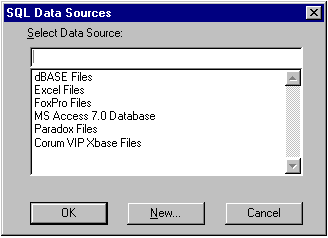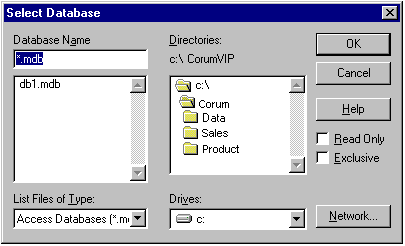
Note
nBefore you save a table part, it is a good idea to save the project first. This ensures that a dictionary will be created for the table in case you would like to create English statement queries. For instructions on how to save the project, click here 
In VIP Workshop, you can create a new table or you connect a table to existing data. The first time you save a new table, you must select the ODBC-compliant data source to save the table as. If you connected the table to existing data, then you need to specify the location of the data source and type in a name for the table part.
1In table view, click the Save button  ; or choose Save Data Table from the File menu.
; or choose Save Data Table from the File menu.
If this is the first time you are saving the table, the Save As dialog box appears. Otherwise, the table is saved.
2Select a location for the table part file.
3In the File name edit box, type in the name for the table and click the Save button. Note that you do not need to type in the *.Tbl extension. Also, some ODBC drivers will not accept a name which is more than eight characters long.
If you have connected this table part to existing data, the table is saved. Otherwise, if this a newly created table, you must select an ODBC-compliant data source to save the table as. For more information on ODBC, see What is ODBC? If this is the case, the SQL Data Sources dialog box appears.

Note
nYour ODBC Manager dialog box may appear different than the one above. Its appearance depends on which ODBC Administrator you have installed.
4Select a data source from the list box and click the OK button.
If the ODBC-compliant data source you want does not appear in the list, then either 1) you need to install its ODBC driver first, or 2) the data source you want has not been defined for a particular ODBC driver. This means that you have not determined how the ODBC driver is to read the specified data. If this is the case, click here for further instructions 
5Depending on what data source you selected in the SQL Data Sources dialog box, the Select Database dialog box may appear. If it appears, this indicates that the data source you selected requires you to specify a database file. For example, if you selected MS Access 7.0 as the data source, you must select a database file (or *.mdb file). For more information, see Special Note for Particular Data Formats. In the Select Database dialog box, locate the database file and click the OK button.

Note
nA different type of dialog box may display than the one pictured above; or no dialog may display, in which case you will need to type the appropriate information into the Connect database option of the Data Table drawer directly.
With other data formats, such as dBASE, the database is not a file; it is the directory that contains the tables of data. If you have selected one of these data sources in the SQL Data Sources dialog box, then the Select Database dialog box will not appear. A default path to the table file will automatically display in the Connect database option of the Data Table drawer. If needed, open the Data Table drawer and click on the Connect database edit box to modify the path.
The table is saved.